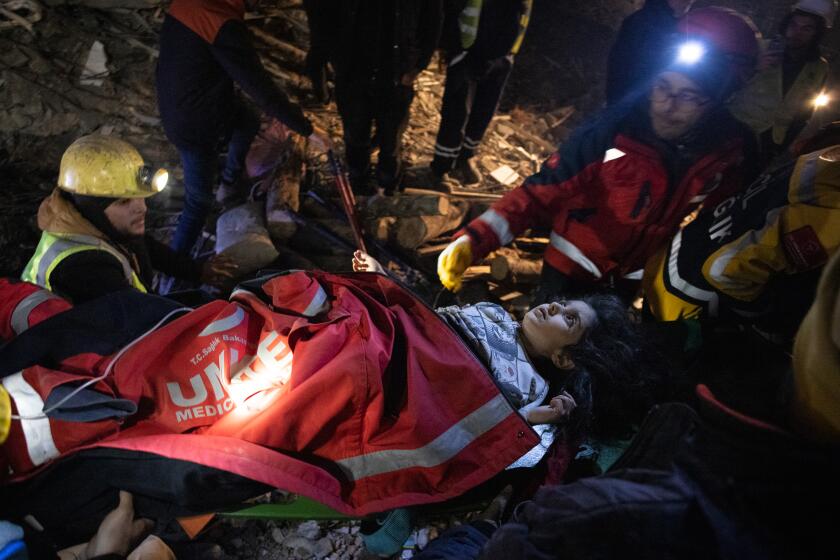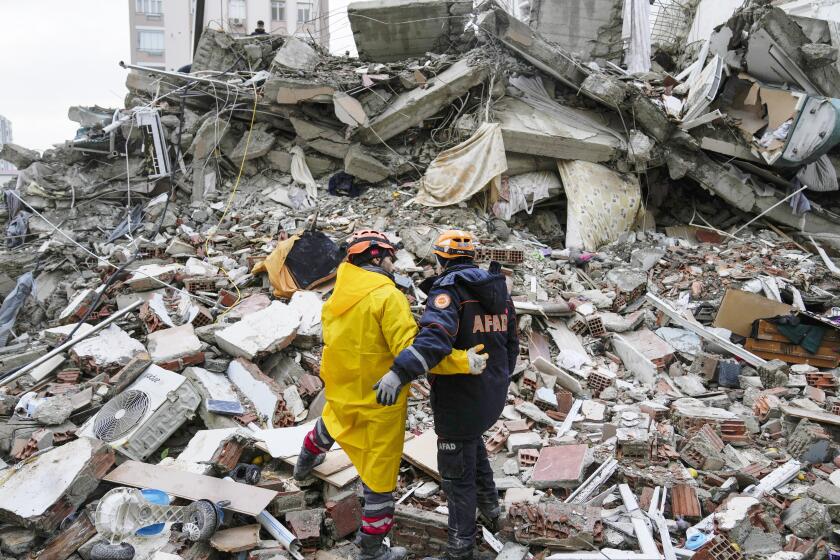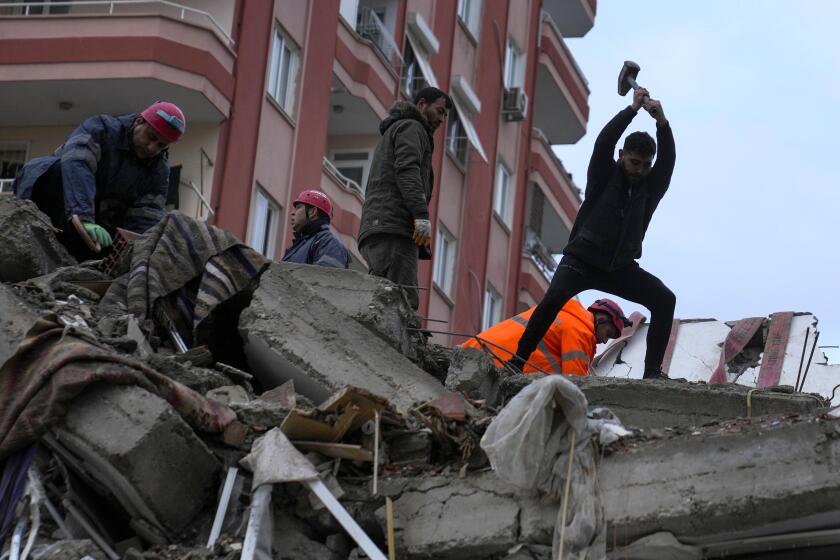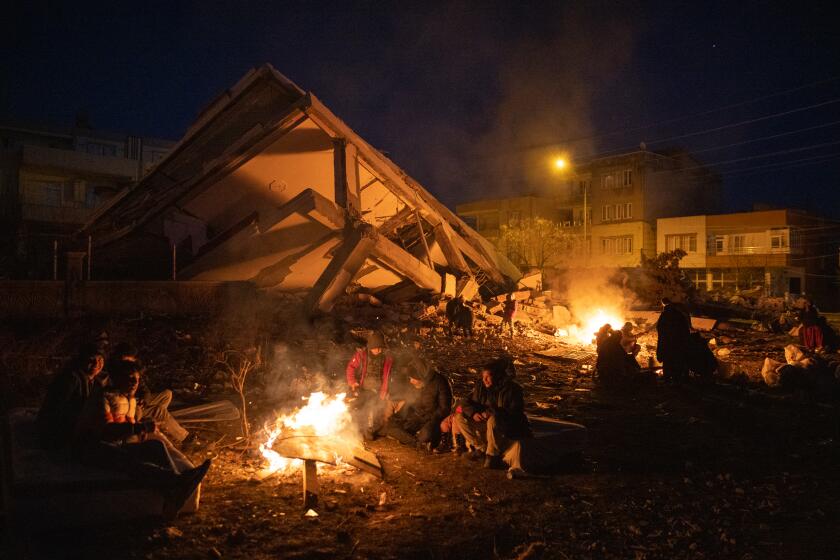With death toll above 35,000, search for quake survivors enters final hours in Turkey and Syria
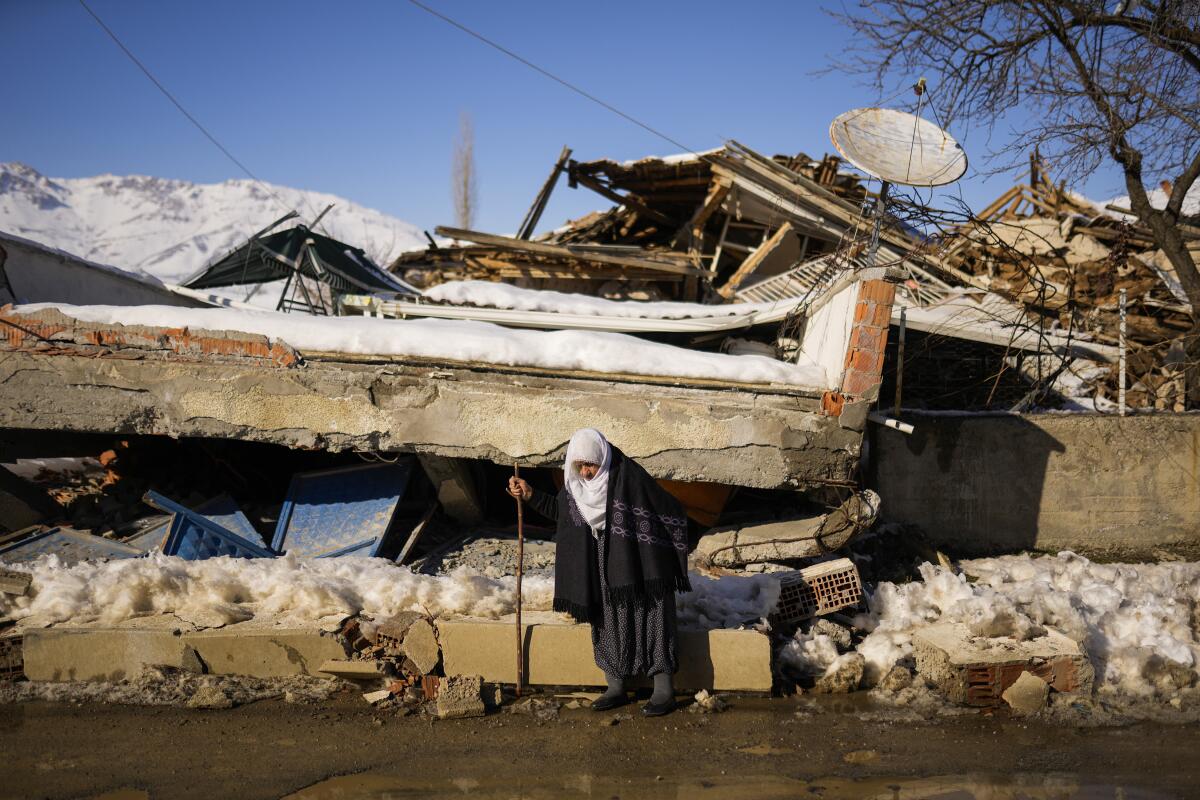
- Share via
ADIYAMAN, Turkey — The search for earthquake survivors in Turkey and Syria entered its final hours Monday as rescuers using sniffer dogs and thermal cameras surveyed pulverized apartment blocks for any sign of life a week after the disaster.
Teams in southern Turkey’s Hatay province cheered and clapped when a 13-year-old boy, Kaan, was pulled from the rubble. In Gaziantep province, rescue workers, including coal miners who secured tunnels with wooden supports, found a woman alive in the wreckage of a five-story building.
Stories of such rescues have filled the airwaves in recent days. But tens of thousands of dead have been found, and experts say the window for rescues has nearly closed, given the time that has passed, the fact that temperatures have fallen to about 21 degrees Fahrenheit and the severity of the building collapses.
In the days since the magnitude 7.8 earthquake struck Turkey, search-and-rescue teams, including one from Los Angeles County, have been a ubiquitous presence.
The magnitude 7.8 earthquake and its aftershocks struck southeastern Turkey and northern Syria on Feb. 6, reducing swaths of towns and cities to mountains of broken concrete and twisted metal. The death toll has surpassed 35,000.
In some areas, searchers placed signs that read “ses yok,” or “no sound,” outside buildings they had inspected for any sign that someone was alive, HaberTurk television reported.
Associated Press journalists in Adiyaman saw a sign painted on a concrete slab in front of wreckage indicating that an expert had inspected it. In Antakya, people left signs displaying their phone numbers and asking crews to contact them if they found bodies in the rubble.
The quake’s financial damage in Turkey was estimated at $84.1 billion, according to the Turkish Enterprise and Business Confederation, a nongovernmental business organization. Calculated using a statistical comparison with a similarly devastating 1999 quake, the figure was considerably higher than any official estimates so far.
The flaws of non-ductile concrete construction are found across California, with many buildings having not been evaluated or retrofitted and at risk of collapse in a serious earthquake.
In other developments, Syria’s president agreed to open two new crossing points from Turkey to the country’s rebel-held northwest to deliver desperately needed aid and equipment for millions of earthquake victims, the United Nations announced.
U.N. Secretary-General Antonio Guterres welcomed the decision by Syrian leader Bashar Assad to open crossing points at Bab Al-Salam and Al Raée for an initial period of three months. The U.N. has been allowed to deliver aid to the northwest Idlib area through a crossing at Bab Al-Hawa.
Some 62 miles from the epicenter, almost no houses were left standing in the Turkish village of Polat, where residents salvaged refrigerators, washing machines and other goods from wrecked homes.
Not enough tents have arrived for the homeless, forcing families to share, survivor Zehra Kurukafa said.
“We sleep in the mud, all together with two, three, even four families,” Kurukafa said.
Turkish authorities said Monday that more than 150,000 survivors have been moved to shelters outside the affected provinces. In the city of Adiyaman, Musa Bozkurt waited for a vehicle to bring him and others to western Turkey.
The San Andreas fault is capable of magnitude 7.8 earthquakes. Two have occurred twice in recent times: the 1906 San Francisco earthquake and one in 1857 in Southern California.
“We’re going away, but we have no idea what will happen when we get there,” the 25-year-old said. “We have no goal. Even if there was [a plan], what good will it be after this hour? I no longer have my father or my uncle. What do I have left?”
Fuat Ekinci, a 55-year-old farmer, was reluctant to leave his home for western Turkey, saying he did not have the means to live elsewhere and that his fields need to be tended.
“Those who have the means are leaving, but we’re poor,” he said. “The government says, ‘Go and live there a month or two.’ How do I leave my home? My fields are here. This is my home. How do I leave it behind?”
Volunteers from across Turkey have mobilized to help millions of survivors, including a group of chefs and restaurant owners who served traditional food such as beans and rice and lentil soup to those who lined up in the streets of downtown Adiyaman.
The damage included heritage sites in places such as Antakya, on the southern coast of Turkey, an important ancient port and early center of Christianity historically known as Antioch. Greek Orthodox churches in the region have started charity drives to assist the relief effort and raise funds to rebuild or repair churches.
Breaking News
Get breaking news, investigations, analysis and more signature journalism from the Los Angeles Times in your inbox.
You may occasionally receive promotional content from the Los Angeles Times.
In Syria, authorities said a newborn whose mother gave birth while trapped under the rubble of their home was doing well. The baby, Aya, was found hours after the quake, still connected by the umbilical cord to her mother, who was dead. She is being breastfed by the wife of the director of the hospital where she is being treated.
Eduardo Reinoso Angulo, a professor at the Institute of Engineering at the National Autonomous University of Mexico, said the likelihood of finding people alive was “very, very small now.”
David Alexander, a professor of emergency planning and management at University College London, said the odds were not very good to begin with.
Many buildings were so poorly constructed that they collapsed into very small pieces, leaving few spaces for people to survive in, Alexander said.
“If a frame building of some kind goes over, generally speaking we do find open spaces in a heap of rubble where we can tunnel in,“ Alexander said. “Looking at some of these photographs from Turkey and from Syria, there just aren’t the spaces.”
Hundreds of thousands of people have been killed by earthquakes since the turn of the century, including an estimated 316,000 in Haiti in 2010.
Winter conditions further reduced the window for survival. In the cold, the body shivers to keep warm; but that burns a lot of calories, meaning that people also deprived of food will die more quickly, said Dr. Stephanie Lareau, a professor of emergency medicine at Virginia Tech in the U.S.
Many in Turkey blame faulty construction for the devastation, and authorities have begun targeting contractors allegedly linked with buildings that collapsed. Turkey has introduced construction codes that meet earthquake-engineering standards, but experts say the codes are rarely enforced.
As the scale of the disaster has come into view, sorrow and disbelief have turned to rage over the sense that the emergency response was ineffective. That anger could be a political problem for Turkish President Recep Tayyip Erdogan, who faces a tough reelection in May.
The call went out to Los Angeles County Fire Department Urban Search and Rescue members to see who could deploy after the massive earthquake in Turkey.
Turkey’s death toll has exceeded 31,000, and the health minister said more than 19,000 survivors were being treated in hospitals. Deaths in Syria, split between rebel-held areas and government-held areas, have risen beyond 3,500, although those reported by the government haven’t been updated in days.
U.N. spokesman Stephane Dujarric said U.N. humanitarian chief Martin Griffiths met Monday with Syria’s President Bashar Assad and foreign minister after seeing the devastating damage in Aleppo.
Dujarric stressed that the United Nations doesn’t have heavy equipment for excavations or search-and-rescue efforts.
“The international community as a whole needs to step up to get that aid where it’s needed,” he said.
In addition, the U.N.’s humanitarian partners need ambulances, medicine, shelters, heaters and emergency food, water and sanitation and hygiene items, Dujarric said.
More to Read
Sign up for Essential California
The most important California stories and recommendations in your inbox every morning.
You may occasionally receive promotional content from the Los Angeles Times.
